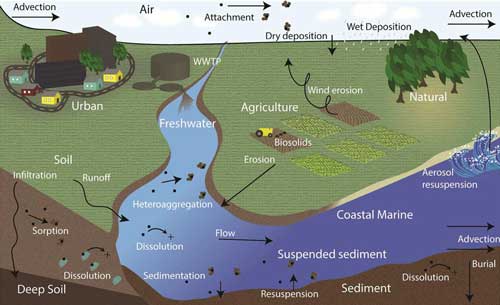| Posted: May 10, 2017 | |
The nanoFate model assesses the risk of engineered nanomaterials in the environment(Nanowerk News) While there is currently no evidence that engineered nanomaterials (ENMs) pose a significant threat to the environment, many gaps in our knowledge remain with regard to ENM ecotoxicity. The lack of evidence should by no means be interpreted to imply that environmental damage cannot occur (read more: Nanotechnology and the environment – Hazard potentials and risks). |
|
| Researchers at the University of California, Santa Barbara, have developed a dynamic multimedia fate and transport model (nanoFate; not to be confused with the European NanoFATE project that ran from 2010 to 2014) to predict the time-dependent accumulation of metallic engineered nanomaterials across environmental media. | |
 |
|
| Conceptual model with compartments, major transfers, and transformations used in nanoFate. (© ACS) (click on image to enlarge) | |
| Compared to previous ENM fate models such as MendNano and SimpleBox4Nano, nanoFate considers a wider range of ENM processes, including emissions to air, water (freshwater and marine), and soils (urban, agricultural, undeveloped) from their manufacturing, use, and disposal; advection in and out of main environmental compartments; rate-limited transport across compartments; resuspension to air and attachment to aerosols; transformation into other ENMs or compounds; in natural waters aggregation, sedimentation, dissolution, filtration, and sorption to suspended particles and the subsequent deposition to sediment. | |
| Since some ENMs also dissolve over time, nanoFate accounts for long-term accumulation of both nanoparticles and dissolved metal ions. nanoFate is also designed to allow for the inclusion of other key transformations processes (e.g., oxidation, sulfidation, adsorption of natural organic matter, loss of the original coating) that alter their chemical properties and environmental behavior, though these are not yet sufficiently understood to incorporate into a mathematical model. | |
| nanoFate has been presented in a recent paper in Environmental Science & Technology ("Assessing the Risk of Engineered Nanomaterials in the Environment: Development and Application of the nanoFate Model"). | |
| As the researchers write in their paper, nanoFate is unique because of | |
|
|
|
| In addition, because of the rapid progress being made in ENM production and applications, they explore a range of release scenarios and corresponding longterm [ENM] estimates. | |
| nanoFate will be publically available and has been developed with extensibility to other environments, ENMs, and for additional processes. |
 By
Michael
Berger
– Michael is author of three books by the Royal Society of Chemistry:
Nano-Society: Pushing the Boundaries of Technology,
Nanotechnology: The Future is Tiny, and
Nanoengineering: The Skills and Tools Making Technology Invisible
Copyright ©
Nanowerk LLC
By
Michael
Berger
– Michael is author of three books by the Royal Society of Chemistry:
Nano-Society: Pushing the Boundaries of Technology,
Nanotechnology: The Future is Tiny, and
Nanoengineering: The Skills and Tools Making Technology Invisible
Copyright ©
Nanowerk LLC
|
|
|
Subscribe to a free copy of one of our daily Nanowerk Newsletter Email Digests with a compilation of all of the day's news. |
